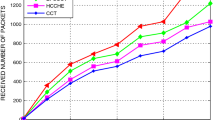Abstract
Due to recent advances in wireless communication technologies, there has been a rapid growth in wireless sensor networks research during the past few decades. Many novel architectures, protocols, algorithms, and applications have been proposed and implemented. The efficiency of these networks is highly dependent on routing protocols directly affecting the network life-time. Clustering is one of the most popular techniques preferred in routing operations. In this paper, a novel energy efficient clustering mechanism, based on artificial bee colony algorithm, is presented to prolong the network life-time. Artificial bee colony algorithm, simulating the intelligent foraging behavior of honey bee swarms, has been successfully used in clustering techniques. The performance of the proposed approach is compared with protocols based on LEACH and particle swarm optimization, which are studied in several routing applications. The results of the experiments show that the artificial bee colony algorithm based clustering can successfully be applied to WSN routing protocols.














Similar content being viewed by others
References
Akyildiz, I., & Mehmet, C. V. (2010). WSN applications. Wireless Sensor Networks, 1, 17–35.
Giuseppe, A., Marco, C., Mario, D. F., & Andrea, P. (2009). Energy conservation in wireless sensor networks: A survey. Ad Hoc Networks, 7, 537–568.
Yang, J., Zhang, C., Li, X., Huang, Y., Fu, S., et al. (2010). Integration of wireless sensor networks in environmental monitoring cyber infrastructure. Wireless Networks, 16(4), 1091–1108.
Akyildiz, I., Su, W., Sankarasubramaniam, Y., & Cayirci, E. (2002). Wireless sensor networks: A survey. Computer Networks, 38, 393–422.
Ergen, S. C., & Varaiya, P. (2010). TDMA scheduling algorithms for wireless sensor networks. Wireless Networks, 16(4), 985–997.
Yick, J., Mukherjee, B., & Ghosal, D. (2008). Wireless sensor network survey. Computer Networks, 52, 2292–2330.
Goldsmith, A. J., & Wicker, S. B. (2002). Design challenges for energy-constrained ad hoc wireless networks. IEEE Wireless Communications, 9, 8–27.
Anastasi, G., Conti, M., Falchi, A., Gregori, E., & Passarella, A. (2004). Performance measurements of motes sensor networks. In Proceedings of the 7th ACM International Symposium on modeling, analysis and simulation of wireless and mobile systems (pp. 174–181).
Crossbow Technology, Inc. (2010). MICAz module datasheet. Available at: http://www.xbow.com/Products/Product_pdf_files/Wireless_pdf/MICAz_Datasheet.pdf.
Al-Karaki, J. N., & Kamal, A. E. (2004). Routing techniques in wireless sensor networks: A Survey. IEEE Wireless Communications, 11, 6–28.
Heinzelman, W., Chandrakasan, A., & Balakrishnan, H. (2000). Energy-efficient communication protocols for wireless microsensor networks. In Proc. hawaaian int. conf. on systems science (pp. 1–10).
Heinzelman, W. (2000). Application specific protocol architectures for wireless networks. PhD Thesis, MIT.
Lindsey, S., & Raghavendra, C. (2002). Pegasis: Power-efficient gathering in sensor networks. In Proceedings of IEEE aerospace conference (Vol. 3, pp. 9–16).
Huang, Y., Wang, N., & Chen, M. (2008). Performance of a hierarchical cluster-based wireless sensor network. In IEEE International Conference on ubiquitous and trustworthy computing (pp. 349–354).
Dorigo, M., & Caro, D. G. (1999). Ant colony optimization: A new meta-heuristic. In Proceedings of CEC99 Congress on Evolutionary Computation (pp. 1470–1477).
Okdem, S., & Karaboga, D. (2009). Routing in wireless sensor networks using an Ant Colony Optimization (ACO) router chip. Sensors, 9, 909–921.
Qing, L., Zhi, T., Yuejun, Y., & Yue, L. (2009). Monitoring in industrial systems using wireless sensor network with dynamic power management. IEEE Sensors Journal, 9, 1596–1604.
Kennedy, J., & Eberhart, R. C. (1995). Particle swarm optimization. In Proc. IEEE Int. Conf. on neural networks (Vol. 4, pp. 1942–1948), Piscataway.
Liang, Y., & Yu, H. (2005). PSO-based energy efficient gathering in sensor networks. Lecture Notes in Computer Science, 3794, 362–369.
Latiff, N. M. A., & Sharif, B. S. (2007). Performance comparison of optimization algorithms for clustering in wireless sensor networks. In IEEE Int. Conf. on mobile adhoc and sensor systems (pp. 1–4), Pisa.
Karaboga, D. (2005). An idea based on honey bee swarm for numerical optimization. In Technical Report-TR06, Erciyes University, Engineering Faculty, Computer Engineering Department.
Karaboga, D., Okdem, S., & Ozturk, C. (2010). Cluster based wireless sensor network routings using artificial bee colony algorithm. In Int. Conf. on autonomous and intelligent systems, AIS’2010 (pp. 1–5), Portugal.
Karaboga, D., & Ozturk, C. (2011). A novel clustering approach: Artificial bee colony (ABC) algorithm. Applied Soft Computing, 11, 652–657.
Karaboga, D., Ozturk, C., & Gorkemli, B. (2011). Probabilistic dynamic deployment of wireless sensor networks by artificial bee colony algorithm. Sensors, 11(6), 6056–6065.
Karaboga, D., Gorkemli, B., Ozturk, C., & Karaboga, N., (2012). A comprehensive survey: artificial bee colony (ABC) algorithm and applications. Artificial Intelligence Review. doi:10.1007/s10462-012-9328-0.
Thomas, A. B., Christopher, M., Szymanski, B. K., & Branch, J. W. (2008). Self-selecting reliable paths for wireless sensor network routing. Computer Communications, 31, 3799–3809.
Bajaj, L., Takai, M., Ahuja, R., Tang, K., Bagrodia, R., & Gerla, M. (1999). GloMoSim: A scalable network simulation environment. In Technical Report 990027, Computer Science Department, University of California, Los Angeles.
Liu, Z., Kwiatkowska, M. Z, & Constantinou, C. (2005). A biologically inspired qos routing algorithm for mobile ad hoc networks. In Int. conf. on adv. inf. network applications (pp. 426–431).
GPI Research Group. CR1216 Battery catalog. GPI International Ltd., Available at http://www.gpbatteries.com/pic/CR1216_DS.pdf.
Author information
Authors and Affiliations
Corresponding author
Additional information
A Shorter version of this paper appeared in AIS 2010.
Rights and permissions
About this article
Cite this article
Karaboga, D., Okdem, S. & Ozturk, C. Cluster based wireless sensor network routing using artificial bee colony algorithm. Wireless Netw 18, 847–860 (2012). https://doi.org/10.1007/s11276-012-0438-z
Published:
Issue Date:
DOI: https://doi.org/10.1007/s11276-012-0438-z




